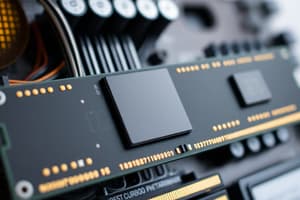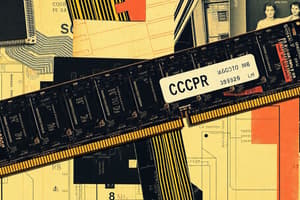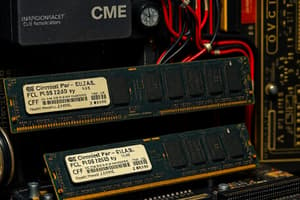Podcast
Questions and Answers
Which of the following best describes a computer?
Which of the following best describes a computer?
- A storage unit for books and documents.
- A communication tool used only for sending emails.
- A mechanical device used for calculations.
- An electronic device that processes data according to a set of instructions. (correct)
What is the primary function of the motherboard?
What is the primary function of the motherboard?
- To perform complex calculations.
- To store data permanently.
- To connect all components of the computer and allow communication between them. (correct)
- To provide power to the computer.
Which component is often referred to as the 'brain' of the computer?
Which component is often referred to as the 'brain' of the computer?
- CPU (correct)
- Motherboard
- Hard Drive
- RAM
What is the primary function of RAM?
What is the primary function of RAM?
Which storage device uses flash memory to store data?
Which storage device uses flash memory to store data?
What is the role of the Power Supply Unit (PSU) in a computer?
What is the role of the Power Supply Unit (PSU) in a computer?
Which component is essential for rendering images and videos, especially in gaming and graphic design?
Which component is essential for rendering images and videos, especially in gaming and graphic design?
What is the purpose of a computer's cooling system?
What is the purpose of a computer's cooling system?
Which of the following is an example of an input device?
Which of the following is an example of an input device?
Which of the following connectors primarily transmits uncompressed digital video?
Which of the following connectors primarily transmits uncompressed digital video?
Which connector is most versatile, used for data transfer and power supply between devices?
Which connector is most versatile, used for data transfer and power supply between devices?
Which connector is an older analog video connector and does not carry audio?
Which connector is an older analog video connector and does not carry audio?
Which port is used for wired network connections?
Which port is used for wired network connections?
What is the primary function of a motherboard in a computer system?
What is the primary function of a motherboard in a computer system?
Which of the following is NOT a function of the circuitry contained within a motherboard?
Which of the following is NOT a function of the circuitry contained within a motherboard?
What unit is used to measure CPU speed?
What unit is used to measure CPU speed?
What is the role of the Arithmetic Logic Unit (ALU) within the CPU?
What is the role of the Arithmetic Logic Unit (ALU) within the CPU?
Which of the following accurately describes the function of CPU registers?
Which of the following accurately describes the function of CPU registers?
If a CPU has a clock speed of 3.5 GHz, what does this indicate?
If a CPU has a clock speed of 3.5 GHz, what does this indicate?
Identify the first step in a machine cycle?
Identify the first step in a machine cycle?
Which of the following best describes computer architecture?
Which of the following best describes computer architecture?
Which unit is responsible for managing and directing operations within the von Neumann architecture?
Which unit is responsible for managing and directing operations within the von Neumann architecture?
Which component stores both data and instructions in the von Neumann architecture?
Which component stores both data and instructions in the von Neumann architecture?
Which of the following memory types is volatile?
Which of the following memory types is volatile?
Which type of RAM is known for its low power cost and is often used for CPU cache?
Which type of RAM is known for its low power cost and is often used for CPU cache?
Which memory type functions like both RAM and ROM, allowing information to be written and retained without power?
Which memory type functions like both RAM and ROM, allowing information to be written and retained without power?
In the context of memory addresses, what is a logical address?
In the context of memory addresses, what is a logical address?
What is the purpose of a page table in a virtual memory system?
What is the purpose of a page table in a virtual memory system?
What is the term 'physical address space' used for?
What is the term 'physical address space' used for?
Which internal adaptation mechanism extends a computer's functionality beyond its built-in capabilities?
Which internal adaptation mechanism extends a computer's functionality beyond its built-in capabilities?
What is the primary function of a video card?
What is the primary function of a video card?
What is the role of ports in a computer system?
What is the role of ports in a computer system?
Which of the following is the correct order of speed (fastest to slowest) for these components: CPU Registers, Main Memory (RAM), SSD (SATA), Hard Drive (SATA)?
Which of the following is the correct order of speed (fastest to slowest) for these components: CPU Registers, Main Memory (RAM), SSD (SATA), Hard Drive (SATA)?
Which of the following is NOT an external peripheral?
Which of the following is NOT an external peripheral?
Besides a monitor, which of the following is considered an output device?
Besides a monitor, which of the following is considered an output device?
What is the function of external peripherals in a computer system?
What is the function of external peripherals in a computer system?
Imagine you have a computer that is running extremely slow. Analyzing its specifications, you notice it has a fast CPU and a large amount of RAM, but it's still underperforming. Given what you know about computer components, which of the following is most likely the bottleneck?
Imagine you have a computer that is running extremely slow. Analyzing its specifications, you notice it has a fast CPU and a large amount of RAM, but it's still underperforming. Given what you know about computer components, which of the following is most likely the bottleneck?
Examine the following scenario: A computer user is experiencing intermittent display issues with their monitor. The monitor sometimes shows distorted images or fails to display anything at all. They have tried a different monitor with the same cable and the issue persists. Considering potential connector-related problems, what THREE components would you test or replace to best address this issue?
Examine the following scenario: A computer user is experiencing intermittent display issues with their monitor. The monitor sometimes shows distorted images or fails to display anything at all. They have tried a different monitor with the same cable and the issue persists. Considering potential connector-related problems, what THREE components would you test or replace to best address this issue?
Flashcards
What is a computer?
What is a computer?
An electronic device that processes data according to a set of instructions (a program).
Personal Computer (PC)
Personal Computer (PC)
Designed for individual use, typically for word processing, internet browsing and gaming.
Laptops
Laptops
Portable computers that combine the components of a desktop PC into a single unit.
Tablets
Tablets
Signup and view all the flashcards
Servers
Servers
Signup and view all the flashcards
Supercomputers
Supercomputers
Signup and view all the flashcards
Motherboard
Motherboard
Signup and view all the flashcards
Chipset
Chipset
Signup and view all the flashcards
Memory (RAM)
Memory (RAM)
Signup and view all the flashcards
Storage (Hard Drive / SSD)
Storage (Hard Drive / SSD)
Signup and view all the flashcards
Power Supply Unit (PSU)
Power Supply Unit (PSU)
Signup and view all the flashcards
Graphics Processing Unit (GPU)
Graphics Processing Unit (GPU)
Signup and view all the flashcards
Cooling System
Cooling System
Signup and view all the flashcards
DVI (Digital Visual Interface)
DVI (Digital Visual Interface)
Signup and view all the flashcards
HDMI (High-Definition Multimedia Interface)
HDMI (High-Definition Multimedia Interface)
Signup and view all the flashcards
USB (Universal Serial Bus)
USB (Universal Serial Bus)
Signup and view all the flashcards
DisplayPort
DisplayPort
Signup and view all the flashcards
VGA (Video Graphics Array)
VGA (Video Graphics Array)
Signup and view all the flashcards
Ethernet (RJ-45)
Ethernet (RJ-45)
Signup and view all the flashcards
Motherboard
Motherboard
Signup and view all the flashcards
Central Processing Unit (CPU)
Central Processing Unit (CPU)
Signup and view all the flashcards
Control Unit
Control Unit
Signup and view all the flashcards
Arithmetic Logic Unit (ALU)
Arithmetic Logic Unit (ALU)
Signup and view all the flashcards
Computer architecture
Computer architecture
Signup and view all the flashcards
Random-Access Memory (RAM)
Random-Access Memory (RAM)
Signup and view all the flashcards
Read-Only Memory (ROM)
Read-Only Memory (ROM)
Signup and view all the flashcards
Flash Memory
Flash Memory
Signup and view all the flashcards
Memory addresses
Memory addresses
Signup and view all the flashcards
Logical Addresses
Logical Addresses
Signup and view all the flashcards
Physical Addresses
Physical Addresses
Signup and view all the flashcards
Adapter Cards
Adapter Cards
Signup and view all the flashcards
Video Card
Video Card
Signup and view all the flashcards
Sound Card
Sound Card
Signup and view all the flashcards
Ports
Ports
Signup and view all the flashcards
Mouse
Mouse
Signup and view all the flashcards
Keyboard
Keyboard
Signup and view all the flashcards
Study Notes
- A computer is an electronic device that processes data according to a program.
- Computers perform calculations, data storage, and communication.
- Hardware, such as the processor, memory, and storage devices, and software, which includes programs and operating systems, make up computers.
- Some different types of computers are: Personal Computers (PCs), Laptops, tablets, servers and supercomputers.
- Computers have become integral to modern life and are used in education, business, healthcare, and entertainment.
Main Computer Components and Functions
- Motherboard: The main circuit board that connects all computer components, enabling communication between the CPU, memory, storage, and peripherals.
- CPU: Performs calculations and executes instructions from programs: the "brain" of the computer.
- Memory (RAM): Temporary storage that the CPU uses for actively used data and instructions.
- Storage (Hard Drive / SSD): Used to permanently store data, including the operating system, applications, and user files.
- Power Supply Unit (PSU): Converts electrical power from an outlet into usable power for the computer's components.
- Graphics Processing Unit (GPU): Handles rendering of images, video, and animations; essential for gaming and graphic design.
- Cooling System: Maintains optimal operating temperatures for components.
- Input/Output Devices: Allow users to interact with the computer.
Computer Connectors and Ports
- DVI (Digital Visual Interface): Connects video sources to displays, transmitting uncompressed digital video.
- HDMI (High-Definition Multimedia Interface): Transmits high-definition video and audio from a source to a display; widely used in consumer electronics.
- USB (Universal Serial Bus): A versatile connector for data transfer and power supply between devices.
- DisplayPort: A digital display interface used to connect a video source to a monitor, supporting high resolutions and refresh rates, suitable for gaming.
- VGA (Video Graphics Array): An older analog video connector for transmitting video signals.
- Ethernet (RJ-45): Used for wired network connections, connecting devices to local area networks (LAN) and the internet.
Motherboard
- The primary printed circuit board (PCB) in a computer.
- The central hub connects CPU, memory modules, storage devices, expansion cards, and peripheral devices.
- Provides electrical connections and pathways for data transfer.
- Facilitates communication and coordination between components.
- Includes interfaces for external connections like USB ports, audio jacks, network ports, and display outputs.
- Contains circuitry for power regulation, BIOS firmware storage, and system management functions.
Central Processing Unit (CPU)
- Performs most decision-making, arithmetic, and data manipulation.
- Executes billions of instructions per second.
- Operation controlled by a program (list of instructions).
- Speed measured in gigahertz (GHz).
- Main Components: Control Unit, Arithmetic Logic Unit (ALU), and Registers.
- Machine Cycle Steps: Fetch, decode, execute, and store.
Computer Architecture
- Design of a computer system, including components and their organization.
- It encompasses both hardware and software aspects.
- Defines the structure and behavior of a computer system.
- Key Components of von Neumann Architecture.
- The processing Unit contains an Arithmetic Logic Unit (ALU) and processor registers.
- Control Unit: Manages and directs operations.
- Memory stores both data and instructions.
- External Mass Storage provides additional data storage.
- Computer Ports facilitate connections to peripherals.
- Input and Output Devices allow user interaction and data display.
- Influences execution speed and effectiveness of running various applications.
Memory
- Encompasses various types of storage for temporarily or permanently holding data and instructions.
- Primary Types of Memory: Random-Access Memory (RAM), Read-Only Memory (ROM) & Cache Memory.
- RAM provides fast but volatile storage for active data and programs and is cleared when the computer is off.
- ROM holds essential system instructions and firmware and is non-volatile
- Cache Memory is high-speed storage close to the CPU for frequently accessed data.
- Includes Secondary Storage: Hard Disk Drives (HDDs) and Solid-State Drives (SSDs).
- Affects system performance and multitasking capabilities.
- Shapes a computer’s functionality and responsiveness.
Memory Addresses
- Numerical identifiers for locations within a computer's memory.
- Each byte of memory has a unique address for data access and manipulation by the CPU.
- Types of Memory Addresses.
- Logical Addresses are generated by the CPU while a program is running and used as a reference to access physical memory.
- Physical Addresses identify the actual physical location of data in memory.
- A page table stores the mapping between virtual and physical addresses in a virtual memory system.
Peripherals
- Computers use internal adaptation mechanisms, primarily adapter cards and ports, to connect with components and peripherals.
- Adapter Cards are inserted into motherboard slots to extend functionality beyond built-in capabilities.
- Ports are physical or virtual interfaces that facilitate connections to external devices.
- Adapter Cards, An internal expansion cards that allow communication with peripherals.
- Ports are interfaces on a computer that enable communication with external peripherals or networks, acting as gateways for data transfer.
- Speed comparisons vary: the fastest are CPU Registers, then CPU Caches, then Main Memory (RAM) then SSD.
- External Peripherals Augment a computer's capabilities beyond core components: input devices (Keyboards, mice), output devices (Monitors, speakers) networking devices etc
Studying That Suits You
Use AI to generate personalized quizzes and flashcards to suit your learning preferences.




